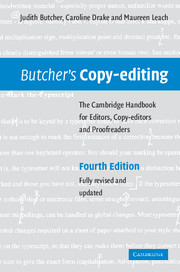Book contents
- Frontmatter
- Contents
- List of illustrations
- Preface to the fourth edition
- Preface to the third edition
- Preface to the second edition
- Preface to the first edition
- Acknowledgements
- 1 Introduction
- 2 Preliminary copy-editing, design and specimen pages
- 3 Preparing the text for the typesetter
- 4 Illustrations
- 5 Proofs
- 6 House style
- 7 Preliminary pages
- 8 Indexes
- 9 Other parts of a book
- 10 Bibliographical references
- 11 Literary material
- 12 Multi-author and multi-volume works
- 13 Science and mathematics books
- 14 Other special subjects
- 15 Reprints and new editions
- 16 On-screen editing
- Appendixes
- Glossary
- Select bibliography and other resources
- Index
2 - Preliminary copy-editing, design and specimen pages
Published online by Cambridge University Press: 05 August 2012
- Frontmatter
- Contents
- List of illustrations
- Preface to the fourth edition
- Preface to the third edition
- Preface to the second edition
- Preface to the first edition
- Acknowledgements
- 1 Introduction
- 2 Preliminary copy-editing, design and specimen pages
- 3 Preparing the text for the typesetter
- 4 Illustrations
- 5 Proofs
- 6 House style
- 7 Preliminary pages
- 8 Indexes
- 9 Other parts of a book
- 10 Bibliographical references
- 11 Literary material
- 12 Multi-author and multi-volume works
- 13 Science and mathematics books
- 14 Other special subjects
- 15 Reprints and new editions
- 16 On-screen editing
- Appendixes
- Glossary
- Select bibliography and other resources
- Index
Summary
On receipt of the typescript or electronic files and hard-copy printout the production controller is likely to ask the typesetter to test or trial the material to make sure that it is satisfactory and to provide a cast-off (calculation of the number of printed pages that the copy will occupy when set in a given typeface and measure), so that the probable cost of producing the book can be estimated. Most publishers work with a small number of typesetters, on agreed scales, so they know in advance in most cases what the setting cost per page will be.
If the book is in a series, or being produced according to a standard design, copy-editing work at this stage is minimal and usually done in-house.
However, there are two circumstances that may lead the commissioning editor to ask for a full design specification to be produced before the book is copy-edited. The first of these is if the book is unusual or specialized; for example, the first volume in a new series. The second is if for various reasons some specimen (sample) pages are required. The typesetter may be asked for sample pages not only to check that the design specification is being interpreted correctly but also to show to the marketing department and the author, especially in the cases where form and function are closely related, such as textbooks, encyclopedias, guides, etc. Several samples may be produced, each with different modifications.
Information
- Type
- Chapter
- Information
- Butcher's Copy-editingThe Cambridge Handbook for Editors, Copy-editors and Proofreaders, pp. 17 - 27Publisher: Cambridge University PressPrint publication year: 2006
